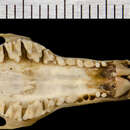Biology
provided by Arkive
The Pyrenean desman seeks shelter in rock crevices, caves, or the burrows of water rats, only rarely digging their own burrows. This species lives in pairs that are typically monogamous, with the male's territory completely encompassing that of the female, although solitary adults also exist (6). Territories are scent-marked and will be defended to the death against intruders (5) (6). The breeding season is from January to May, during which females may breed up to three times (5) (6). Litters of one to five, usually three to four, young are born after a gestation period of about 30 days, and weaning probably takes place after around 30 days (5) (6). Sexual maturity is thought to be attained after approximately two years, but little else is known of the life history patterns of this enigmatic species (5).
The Pyrenean desman feeds nocturnally on a diverse array of crustaceans and insect larvae, including stoneflies and caddis fly larvae (1), although this amphibious mammal may also exhibit short periods of activity during the day (3). Ungainly on land (5), this species is a powerful swimmer and accomplished diver, primarily foraging by sifting through stream sediments with its forefeet and using its extremely tactile and sensitive long snout to search for prey (3). It has been suggested that the Pyrenean desman may also slap the surface of the water to produce noises useful in echolocation to help find its way around and locate underwater prey, but this is only speculation (5) (6).
Conservation
provided by Arkive
The Pyrenean desman and its dwindling habitat are protected in the parts of its range that occur within the Parc National des Pyrénées Occidentales and Parque Nacional de Covadona, and populations may also possibly exist in the Parque Nacional de Aiguas y Lago de San Mauricio and the Parque Nacional de Ordesa. Following an international conference on the conservation of this rare aquatic mammal, an action plan was drawn up to help save the species from further declines (1).
Description
provided by Arkive
Named after the place of its home, the Pyrenean desman is a small aquatic insectivore closely related to moles, also known as the Iberian desman (4) (5). This adept swimmer has many adaptations to its aquatic habitat, including an elongated head and body with a long tail, webbed, paddle-like hindfeet, and the ability to close both ears and nostrils to prevent water getting in (3) (5) (6). In contrast to moles, which have powerful digging front legs, desmans have powerful hind legs that are longer than the forefeet to help propel them through the water (5). The tail is also slightly flattened vertically, acting as a rudder and helping to steer and direct the animal as it swims (7). A double layer of fine dark greyish-brown fur includes a dense waterproof underfur and oily guard hairs (5). The eyes are tiny and eyesight is poor, but the long, black, almost hairless snout is highly sensitive and used to locate prey (2) (5).
Habitat
provided by Arkive
Unlike the only other desman species, the Russian desman (Desmana moschata), the Pyrenean species lives along fast-flowing mountain streams, although it is occasionally found in slower-moving water bodies, including canals, lakes and marshes at altitudes of 60 to 1,200 metres (1) (7).
Range
provided by Arkive
Known from the Pyrenees Mountains and the northern Iberian Peninsula in the countries of France, Spain and Portugal (1) (4).
Status
provided by Arkive
Classified as Vulnerable (VU) on the IUCN Red List (1).
Threats
provided by Arkive
The Pyrenean desman is threatened because it is bound to a very vulnerable habitat within a restricted area. The greatest threat to the species comes from water pollution and habitat fragmentation caused by the construction of hydroelectric plants. Direct persecution from fishermen who mistakenly believe the species competes for fish stocks, especially trout, also poses a threat, as does over harvesting from the wild by eager collectors. In addition, fears have been expressed that North American minx (Mustela vison) escaping from fur farms in northern Iberia may be having a negative impact upon populations. The full impact of these threats is not known as population surveys are notoriously difficult for this aquatic species (1).

